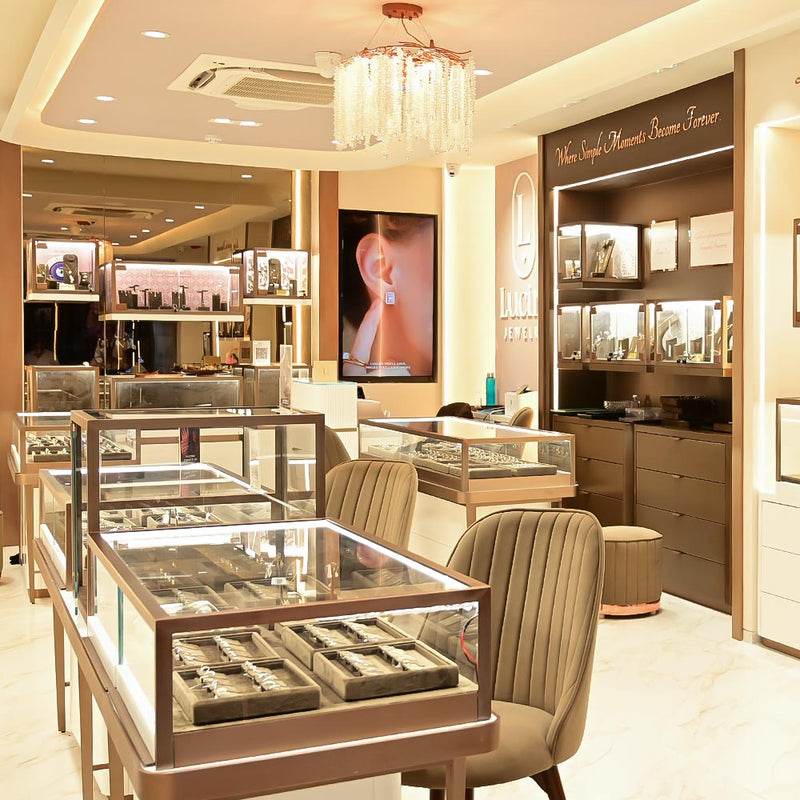Introduction — The Modern Diamond Dilemma
In today’s jewelry landscape, conscious luxury is redefining what it means to shine. Among the most talked-about gemstones are moissanite and lab grown diamond necklace—two dazzling alternatives that combine beauty, sustainability, and innovation.
If you’ve ever found yourself wondering which is better, you’re not alone. Both stones are ethically created, both are brilliant, and both are transforming the fine jewelry industry. But their differences in composition, brilliance, and long-term value make them uniquely suited to different buyers.
At Lucira Jewelry, we believe in celebrating brilliance with purpose. Our mission is to help you understand what truly makes a diamond, or any gemstone worth your love and investment.
What Is a Lab Diamond?

A Lab Grown Diamond is a real diamond. Created in advanced laboratories using innovative technology, these gems are optically, chemically, and physically identical to mined diamonds. The only difference is their origin.
Lab diamonds are grown through processes like HPHT (High Pressure High Temperature) and CVD (Chemical Vapor Deposition), which replicate the natural conditions under which diamonds form deep within the earth.
Each Lucira lab-grown diamond is IGI-certified, conflict-free, and ethically crafted to deliver timeless brilliance without the environmental or social impact of mining.
What Is Moissanite?

Moissanite is a gemstone made from silicon carbide. Originally discovered in a meteor crater, moissanite is now created in laboratories to mimic diamond-like sparkle.
While visually similar to diamonds, moissanite is not carbon-based. Its unique structure creates an intense rainbow-like refraction, giving it a colorful “fire” that is more vibrant than a diamond’s pure white brilliance.
Moissanite’s appeal lies in its affordability and sparkle. However, when compared with lab-grown diamonds, authenticity and optical behavior set them apart.
Moissanite vs Lab Diamond: Key Differences
To understand how these stones compare, here’s a direct overview:
| Feature | Lab Grown Diamond | Moissanite |
| Composition | Pure Carbon | Silicon Carbide |
| Hardness (Mohs) | 10/10 | 9.25/10 |
| Brilliance Type | White Brilliance | Rainbow Fire |
| Certification | IGI / GIA | Limited |
| Price (1 Carat) | ₹30,000–₹40,000 | ₹5,000–₹10,000 |
| Resale Value | High | Low |
| Ethical Impact | 100% Sustainable | Moderately Sustainable |
Both stones are beautiful, but the price difference is significant. Lab-grown diamonds retain more value and authenticity, while moissanite offers a more budget-friendly sparkle.
Sparkle and Beauty — How They Look to the Naked Eye
When it comes to appearance and brilliance, moissanite vs lab diamond is one of the most visually intriguing comparisons in the jewelry world. To the untrained eye, both gemstones can appear remarkably similar, especially when set in fine jewelry. However, under light and closer observation, their differences become beautifully clear.
1. Brilliance and Fire
Both moissanite and lab-grown diamonds are prized for their exceptional sparkle, but the type of sparkle they produce is distinctly different.
- Lab-Grown Diamonds:
Lab diamonds are made of pure carbon, just like natural diamonds. This gives them a refractive index of 2.42, which results in a classic, balanced brilliance. The sparkle of a lab-grown diamond is crisp, white, and elegant—the same timeless glow that has defined diamonds for centuries. This white light reflection is known as brilliance, while the tiny flashes of rainbow-like color are called fire.
When you move a lab-grown diamond under light, you’ll see a refined play of light that feels natural and understated. This is why many couples prefer lab-grown diamonds for engagement rings—they deliver the same radiant beauty as mined diamonds, symbolizing purity and sophistication. - Moissanite:
Moissanite, on the other hand, has a higher refractive index (2.65–2.69), which means it bends light more dramatically. As a result, moissanite gives off a stronger rainbow-like sparkle—an intense fire that can appear colorful under sunlight or indoor lighting.
While many love this vibrant sparkle, others find it a bit “disco-like” or overly flashy compared to the subtler brilliance of a diamond. This is especially noticeable in larger moissanite stones, where the colorful flashes become more pronounced.
In simple terms, lab-grown diamonds sparkle like natural diamonds, while moissanite sparkles like a prism, giving off vivid colors.
2. Clarity and Visual Perfection
Clarity is another area where both stones perform beautifully. Lab-grown diamonds, like natural ones, may have microscopic inclusions—tiny imperfections that occur during formation. However, these inclusions are often invisible to the naked eye, and most lab diamonds graded VS (Very Slightly Included) or higher appear perfectly clean.
Moissanite, being a lab-created gemstone, is generally flawless. It’s produced under controlled conditions, so visible imperfections are rare. However, its intense fire and different refractive properties can sometimes create a slightly different “texture” in brilliance when viewed from certain angles.
When comparing moissanite vs lab grown diamond clarity, both are high-performing, but diamonds offer a more “natural” visual depth and realism that moissanite lacks.
3. Color Differences Under Light
Another key visual distinction lies in color.
High-quality lab-grown diamonds are available in a wide range of color grades—from D (colorless) to J (near-colorless)—allowing buyers to choose based on personal preference and budget. A colorless lab diamond reflects pure white light, giving it a crisp, icy brilliance.
Moissanite, although marketed as colorless, often exhibits yellow, green, or gray undertones, especially in larger carat sizes or under certain lighting conditions. Modern “colorless” moissanite is much improved, but when placed beside a lab-grown diamond, the difference in hue becomes noticeable.
If you’re looking for a truly colorless gemstone, a lab-grown diamond is the more consistent choice.
4. Cut Quality and Precision
Both moissanite and lab-grown diamonds are cut with exceptional precision to maximize brilliance, but their cutting styles differ due to their optical properties.
Lab-grown diamonds are cut with exact symmetry and proportions based on diamond light behavior. The facets are positioned to enhance brilliance, scintillation (sparkle movement), and fire. Each cut—be it round, cushion, oval, or princess—is designed to highlight the diamond’s natural ability to reflect white light.
Moissanite, because of its double refraction, is cut differently to control the dispersion of light. Some moissanites may show a “crushed ice” effect or a kaleidoscope-like sparkle, which can be stunning but less traditional in appearance.
At Lucira Jewelry, every lab grown diamond necklace is precision-cut and certified by IGI, ensuring that each facet aligns perfectly for maximum brilliance and elegance.
Durability and Longevity
Durability is a key factor when choosing between the two.
Diamonds, including lab-grown ones, are the hardest known material on Earth with a perfect 10 on the Mohs scale. They resist scratches and wear, making them ideal for everyday jewelry such as earrings or nose pin sets.
Moissanite is also durable at 9.25, but over time, it can show surface wear or lose its high polish.
Lucira’s lab-grown diamonds are designed to shine for generations. They’re crafted to last, designed to shine, and created to symbolize everlasting love—qualities moissanite can’t fully replicate.
Price Comparison and Long-Term Value
At first glance, moissanite may seem like the more affordable option. However, the value goes beyond the initial cost.
While moissanite rings may start around ₹20,000 to ₹40,000, their resale value is minimal. Lab-grown diamonds from Lucira, starting at approximately ₹80,000, maintain authenticity, certification, and higher resale potential.
Lab-grown diamonds offer both emotional and financial value—making them a smart and sustainable investment.
Lucira’s engagement ring for men and women’s engagement rings start at ₹50,000, combining beauty and integrity for a lifetime of brilliance.
Ethics and Sustainability: The Conscious Choice

Both moissanite and lab-grown diamonds are environmentally conscious alternatives to mined diamonds, but lab-grown diamonds take sustainability a step further.
Lucira’s diamonds are 100% ethically created, certified by IGI, and free from mining or conflict. Every gem represents innovation, responsibility, and respect for the planet.
Moissanite is also lab-created but doesn’t hold the same legacy or certification standards as diamonds.
At Lucira Jewelry, we believe brilliance should never come at the planet’s expense. Choosing a lab-grown diamond means embracing a sustainable future without compromising on luxury.
Which One Should You Choose?
Choosing between lab grown diamonds vs natural diamonds ultimately depends on your values, budget, and what you want your jewelry to represent. Both types of diamonds share the same brilliance, sparkle, and durability — but their stories differ. Understanding those differences can help you make a meaningful choice that aligns with your lifestyle and beliefs.
Choosing Lab Grown Diamonds: Modern, Ethical, and Affordable
If you are drawn to innovation, sustainability, and affordability, lab grown diamonds are the perfect choice. These diamonds are created in advanced laboratories using cutting-edge technology that mirrors the Earth’s natural diamond-growing conditions.
What makes lab grown diamonds so appealing is their eco-friendly and conflict-free origin. No mining, no harm to ecosystems — just pure beauty with a conscience. When comparing lab grown diamonds vs natural diamonds price, the difference can be significant: lab grown diamonds are typically 30–40% more affordable. That means you can select a larger carat size, higher clarity, or better cut without exceeding your budget.
At Lucira Jewelry, our IGI-certified lab grown diamond earrings deliver exceptional sparkle and purity, offering modern luxury that’s accessible and responsible. They’re perfect for couples who value sustainability and wish to begin their journey with a symbol of love that reflects ethical choices.
Choose lab grown diamonds if you:
- Prefer an eco-conscious alternative to traditional diamonds.
- Want more value for your budget without compromising quality.
- Appreciate modern technology and transparent sourcing.
- Desire IGI or GIA certification that guarantees authenticity.
Lab grown diamonds represent the future of fine jewelry—a harmonious blend of science, ethics, and timeless elegance.
Choosing Natural Diamonds: Traditional, Rare, and Symbolic
On the other hand, natural diamonds appeal to those who admire history, rarity, and natural wonder. Each stone carries a journey that began billions of years ago deep within the Earth, making it a one-of-a-kind treasure of time and nature.
For some, the emotional connection and legacy associated with natural diamonds vs lab grown diamonds make the price difference worthwhile. Natural diamonds have a long-established resale market and are often viewed as long-term assets due to their rarity and traditional prestige.
However, buyers should always ensure that their diamonds are sourced responsibly from conflict-free regions. Modern certification processes, such as the Kimberley Process, have greatly improved the traceability and ethical sourcing of mined diamonds.
Choose natural diamonds if you:
- Value heritage, rarity, and natural formation.
- Seek a symbol of timeless tradition.
- Prefer diamonds with potentially higher resale value.
- Appreciate the emotional and historical significance of Earth-mined gems.
Natural diamonds continue to hold a special place in fine jewelry — their geological story and symbolism of endurance make them timeless classics.
Balancing Values: The Best of Both Worlds
If you’re still torn between natural vs lab grown diamonds, think about what matters most to you — is it heritage, sustainability, affordability, or ethics?
- From a value standpoint, lab grown diamonds offer unmatched brilliance for a lower price, making luxury more accessible.
- From a legacy standpoint, natural diamonds retain historical prestige and are often seen as heirloom-worthy treasures.
- From an ethical standpoint, lab grown diamonds are the clear winner, offering guilt-free sparkle without environmental harm.
Ultimately, both lab grown and natural diamonds symbolize love, strength, and commitment. The difference lies in how you define those values — through tradition or innovation.
At Lucira Jewelry, we celebrate both choices. Our expert gemologists curate collections that honor the beauty of lab grown and natural diamonds, allowing you to find the perfect balance between elegance and ethics.
Making Your Decision with Lucira Jewelry
When you shop at Lucira Jewelry, you’re not just buying a diamond — you’re choosing your story. Whether you lean towards lab grown diamonds vs natural diamonds for their ethical appeal or natural diamonds vs lab grown diamonds for their heritage, our team ensures that your purchase reflects integrity, beauty, and value.
Every piece from Lucira Jewelry is IGI-certified and crafted with meticulous attention to detail. Our lab grown diamonds are created using sustainable practices, ensuring that your jewelry shines as brightly as your values.
So, whether you prefer lab grown diamonds for affordability or natural diamonds for their timeless rarity, the choice is deeply personal — and with Lucira, it’s always the right one.
Choose Brilliance with Purpose
Both lab grown and natural diamonds symbolize love, beauty, and commitment—but the way they’re created makes all the difference. Lab grown diamonds offer an ethical, affordable, and sustainable alternative without sacrificing brilliance.
At Lucira Jewelry, we craft more than diamonds—we create meaningful heirlooms for the modern world. Every lab grown diamond is IGI-certified, conflict-free, and designed to shine for generations.
Explore our collection of lab grown diamond rings, necklaces, and bracelets today at Lucira Jewelry and choose a sparkle that aligns with your values.
Moissanite or Lab Diamond — Which Should You Choose?
Your decision depends on your priorities.
| You Should Choose | If You Want |
| Lab-Grown Diamond | A real diamond’s beauty, unmatched durability, long-term value, and ethical sourcing |
| Moissanite | Affordable sparkle and temporary wear without long-term investment |
For engagement rings, anniversaries, or heirloom pieces, lab-grown diamonds offer the authenticity, value, and timeless charm that moissanite simply can’t match.
Lucira’s expert gemologists can help you select the perfect diamond that aligns with your values and vision.
Final Thoughts — The Future of Fine Jewelry
The debate between moissanite and lab-grown diamonds isn’t just about cost or sparkle—it’s about choosing jewelry that reflects your values.
Lab-grown diamonds deliver the brilliance, strength, and authenticity of natural diamonds while supporting a sustainable future. Moissanite offers an affordable, beautiful alternative but lacks the timeless value and heritage of true diamonds.
At Lucira Jewelry, we’re proud to lead India’s lab-grown diamond revolution—where elegance meets ethics and innovation meets tradition.
At Lucira Jewelry, every lab-grown diamond tells a story of innovation, beauty, and integrity. Explore our collection of certified lab grown diamond necklace, engagement rings, and bracelets, each crafted to celebrate your love and your principles.


